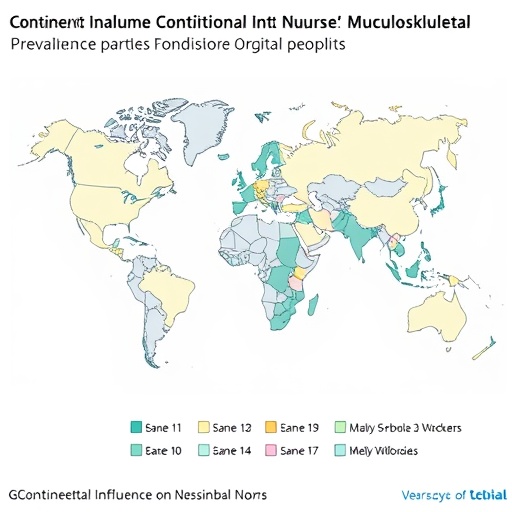The prevalence of work-related musculoskeletal disorders (WRMSDs) among nurses has become a critical global issue, chiefly driven by the physical demands of their profession. In a comprehensive systematic review and meta-analysis conducted by Gorce and Jacquier-Bret, published in BMC Nursing, the researchers delve deep into the continental disparities in the occurrence of these disorders. Their research aims to illuminate the factors contributing to the stress and physical strain nurses endure, ultimately providing insights that could improve working conditions across various regions.
This groundbreaking study scrutinizes the data collected from numerous countries to assess the prevalence of WRMSDs in nursing. It appears that certain continents display a significantly higher rate of reported musculoskeletal disorders among nursing staff compared to others. The researchers utilized diverse methodologies across studies and regions, allowing for a holistic understanding of these alarming trends.
The systematic review not only aggregates existing data but also highlights the geographical nuances of WRMSDs. While the nursing profession is universally recognized for its physical taxing nature, the findings indicate that nurses in regions with specific socio-economic conditions are more susceptible to developing musculoskeletal issues. This revelation stresses the role of environmental, socioeconomic, and organizational factors in the healthcare sector’s integrity.
Within the analysis, the authors emphasized the importance of considering cultural attitudes towards workplace safety and health in various locales. In certain countries, for example, nursing staff may work under significantly less favorable conditions due to insufficient legislative frameworks designed to protect them from occupational hazards. Furthermore, variations in healthcare resources and training may contribute to increased rates of WRMSDs in some regions, underscoring the need for an international dialogue on best practices.
The study’s methodology is noteworthy; it employs rigorous standards to ensure the reliability and validity of the findings. A thorough analysis of data sources ensured that the conclusions drawn are not only statistically significant but also clinically relevant. Gorce and Jacquier-Bret meticulously checked for biases and inconsistencies in the reporting of musculoskeletal disorders, which is typically plagued by underreporting due to stigma or lack of awareness among healthcare workers.
The paper also points to the necessity for more targeted interventions specific to the needs of nursing staff across various locales. As the healthcare landscape continues to evolve, so too must the strategies employed to safeguard the workforce. This research advocates for tailored ergonomic solutions and awareness campaigns aimed at both healthcare institutions and policymakers. These should not only focus on prevention but also on rehabilitation and support systems to assist affected nurses.
Moreover, the findings signal an urgent call for further research into preventative measures. As the healthcare industry acknowledges the rising incidence rates of WRMSDs, the integration of ergonomics into nursing education and ongoing training programs becomes imperative. Developing a comprehensive understanding of the physical strains associated with different nursing duties can lead to innovative solutions that minimize risks.
Interestingly, the study discusses how interdisciplinary collaborations can benefit nursing staff significantly. By fostering partnerships between healthcare providers, occupational health specialists, and ergonomic experts, hospitals can create a safer working environment. Such collaborations can yield actionable strategies aimed at reducing injury rates while enhancing overall job satisfaction among nurses.
Ultimately, the research speaks to a broader narrative regarding the value of healthcare workers. By shining a light on the challenges faced by nursing staff, Gorce and Jacquier-Bret stress the importance of recognizing them as vital asset to health systems worldwide. Acknowledging their struggles can pave the way for more supportive healthcare policies that prioritize worker health and safety.
In conclusion, the findings from Gorce and Jacquier-Bret’s meta-analysis bring to the forefront the pressing issue of WRMSDs among nurses, flanked by geographical disparities. The study serves as a crucial reminder that while nurses remain dedicated to patient care, their own health and wellbeing must not be sidelined. As healthcare continues to evolve in the modern age, so too must the strategies devised to protect and advocate for those who provide essential services.
As a call to action, this research implores healthcare systems globally to reassess their occupational health policies, invest in training, and ensure that the physical demands on nurses are supported by appropriate resources and preventative measures. Each country, regardless of its economic standing, must strive to promote a safer, healthier working environment for nurses, thereby enhancing the quality of care for patients and the conditions under which nurses operate.
Subject of Research: Work-related musculoskeletal disorders among nurses across various continents.
Article Title: Continental effect on work-related musculoskeletal disorders prevalence among nurses: systematic review and meta-analysis.
Article References:
Gorce, P., Jacquier-Bret, J. Continental effect on work-related musculoskeletal disorders prevalence among nurses: systematic review and meta-analysis.
BMC Nurs 24, 1335 (2025). https://doi.org/10.1186/s12912-025-03945-6
Image Credits: AI Generated
DOI: 10.1186/s12912-025-03945-6
Keywords: Work-related musculoskeletal disorders, nursing, systematic review, meta-analysis, healthcare policy, ergonomics.
Tags: environmental factors affecting nursesfactors influencing nurse healthgeographical differences in nursing health issuesglobal disparities in nursing injuriesimproving working conditions for nursesmeta-analysis of nursing injuriesnurses musculoskeletal disorders prevalenceoccupational health in nursingphysical demands of nursing professionsocio-economic impact on nurse well-beingsystematic review of WRMSDswork-related musculoskeletal disorders in nursing





